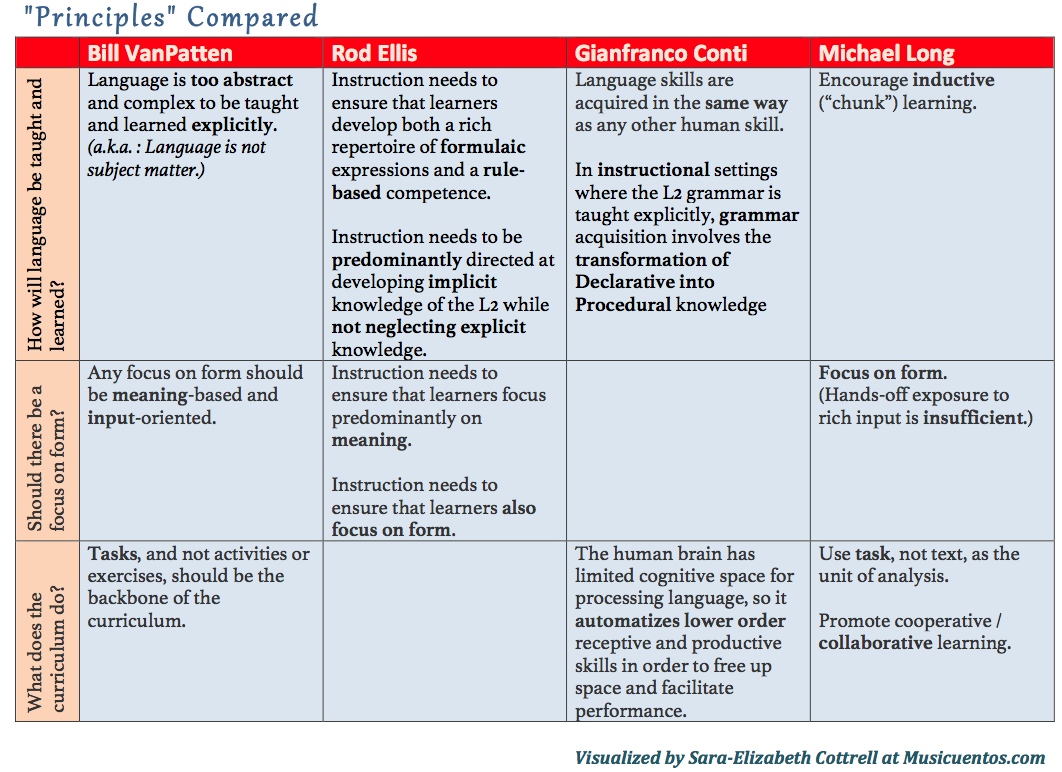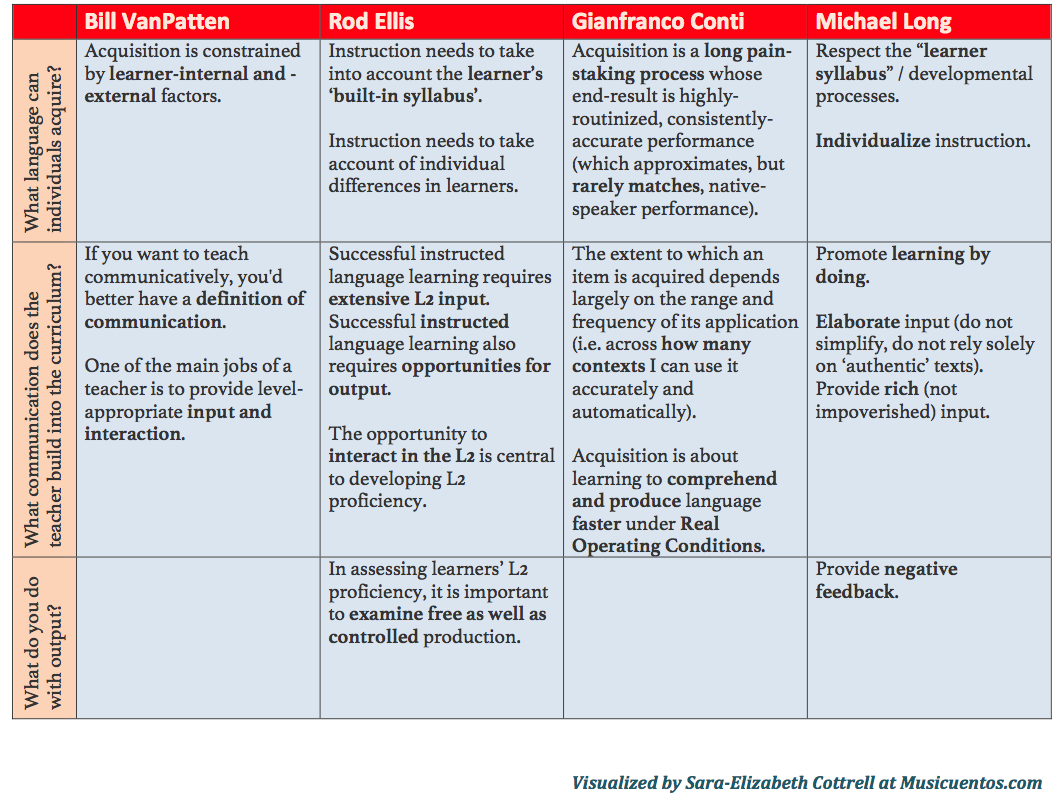Caution: There is danger in listening to only one voice.
Whether in politics or teaching philosophy, we tend to surround ourselves with people who think pretty much like we do. It takes a lot of mental energy to be challenged on closely-held beliefs and defend them, and we’re already spending a lot of mental energy just doing what we do each day. Who has the time?
Still, it’s dangerous. Because what if I’m wrong? It’s happened before and it’ll happen again and it almost always turns into one of my most valuable learning experiences.
Recently, at the Kentucky World Language Association conference, I was talking to my friend Randy Barrette, a longtime high school Spanish teacher who currently works in technology integration at Morehead State University. He and I were talking about how much we’d enjoyed listening to Bill VanPatten’s podcast/internet radio show Tea with BVP last year. Then he mentioned how interested he also was in the blog posts of a certain Gianfranco Conti: “Do you know anything about him?”
Well, yes, I answered, he and I have interacted some online; I was glad to feature his blog on my last annual “Blogs to Watch” post, and enjoyed reviewing a couple chapters of The Language Teacher Toolkit to give him and Steve Smith a bit of U.S. perspective on some topics.
“Can you imagine,” Randy said, “getting him and VanPatten in a room together? I mean, it doesn’t seem like they agree on everything. I’d love to hear that conversation.”
As it turns out, Randy’s not the only one. A month after I first drafted this post, on this very day of posting it, this tweet appeared from @SchwabSpanish:
There you go, Gianfranco and Bill, your loyal fans want to hear you bounce thoughts off each other – I don’t know what time 3:00 p.m. Thursday is in Malaysia – but meanwhile, what I can do is visually represent the “principles” of language teaching as set forth by four very smart guys. Who are they?

I want us to understand that there is no set of the actual right “principles” (that’s why I keep putting the word in quotes). There’s no authority so universally respected that s/he has been allowed to say,
Listen up, I’ve discovered the true ones. These are the real set.
Stuff is contested, and it’s contested by some very smart and informed people. But there’s also much that most leaders in the field agree on. By looking at them side by side, I’m hoping we can say about some issues,
Well, that does seem to be a point of general agreement. What does that mean for my practice?
and about some others,
Hmm, there seems to be some division on that one. What does that mean for my practice?
My sources for these are Bill VanPatten’s spring Tea with BVP episodes, Rod Ellis’s article, Gianfranco Conti’s blog post, and Michael Long’s article (watch the Black Box video!). Note that these are mostly specific to instructed language learning, and that is an important perspective to keep in mind. There’s immersive, naturalistic language acquisition, and then there’s what happens in a classroom, and the two are not the same.
Without further ado, the principles set forth by various researchers, compared side-by-side.


So, what should we do with the voices we’re listening to? What other voices should be part of our learning?
5 Comments
Comments are closed.






There must be principles that are universal to all. Otherwise no two people’s language acquisition process would look the same. In my own language acquisition journey BVP’s ideas make the most sense.
Do any two people’s language acquisition process look the same, though? The “constrained by internal and external factors” part?
I think VanPatten’s “provide level-appropriate input and interaction” and Long’s “promote learning by doing” are the best descriptions of my process. I’m trying to learn Russian now and I don’t actually have a teacher who knows how to give me comprehensible input so I can even have a silent period (I wish I could just sit and listen sometimes!) – everything that’s available to me seems SO incomprehensible. So I have to go out and find stuff and then make it comprehensible for myself. I Skype once a week with a Russian speaker who wants to improve her English and it’s an exhausting opposite of silent period! She’s a native speaker, but she’s not a teacher, so I have to manipulate the interaction into comprehensible input, if that makes sense. For instance, this morning I thought okay, what about talking about places, how about I try “In my city we have a lot of parks.” I thought I was going to get into also “In the park you can walk or run or ride a bicycle,” but no. “In my city we have a lot of parks” was way enough for me. Why does “we have” change if I drop the “in my city” part? What if I want to say “the park is named…” what for “park” then? What about “parks” then? What about changing it to “in my house” or “in my family”? I’m so analytic now I’m just about incapable of unconscious acquisition, so maybe that’s the difference, but I do think those two phrases from Long and VanPatten describe my journey best.
Thanks for the comment!
Admirably open-minded, Sara-Elizabeth. This confusion always makes me want to compromise. Working with Gianfranco has nudged me more in the direction of skill-acquisition, partly brcause I was trained to believe that you could cross the interface, and yet… When you see students after an immersion experience like an exchange you lean back towards natural CI methods. Perhaps it is much about context allied to some general principles. Have come across what the Michaela Comminity School are doing in London. Try having a peep at Barry Smith and Jess Lund’s blogs. I’m sure you can google them. They are having some success with “extreme skill-building” with constant comparison with English, lots of translation, parallel texts and recycling formulaic language. Keep up the good work!
Thanks for the referrals- I will have to check those out! I feel like the more I open my eyes and ears the more I discover I don’t know- and I like it. 🙂
[…] "Queríamos romper con el estereotipo de la mujer cuya belleza está basada en su aspecto externo y mostrar ejemplos de mujeres que tienen belleza interior", le explicó a BBC Mundo Nadia Fink, la autora de los libros. Libertad, creatividad, la búsqueda de justicia, de amor… estas son algunas de las características de las antiprincesas de esta colección. A diferencia de las clásicas historias infantiles, que son ficción, estas antiprincesas no son de fantasía. Son algunas de las mujeres más destacadas de la cultura y la historia latinoamericana. 45 cortometrajes para educar en valores. Nothing is a stretch for your students. VanPatten/Ellis/Conti/Long: “Principles” compared | Musicuentos. […]